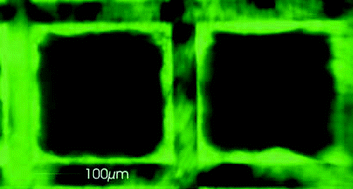A chip-based platform for the in vitro generation of tissues in three-dimensional organization†
Abstract
We describe a multi-purpose platform for the three-dimensional cultivation of tissues. The device is composed of polymer chips featuring a microstructured area of 1–2 cm2. The chip is constructed either as a grid of micro-containers measuring 120–300 × 300 × 300 µm (h × l × w), or as an array of round recesses (300 µm diameter, 300 µm deep). The micro-containers may be separately equipped with addressable 3D-micro-electrodes, which allow for electrical stimulation of excitable cells and on-site measurements of electrochemically accessible parameters. The system is applicable for the cultivation of high cell densities of up to 8 × 106 cells and, because of the rectangular grid layout, allows the automated microscopical analysis of cultivated cells. More than 1000 micro-containers enable the parallel analysis of different parameters under superfusion/perfusion conditions. Using different polymer chips in combination with various types of bioreactors we demonstrated the principal suitability of the chip-based bioreactor for tissue culture applications. Primary and established cell lines have been successfully cultivated and analysed for functional properties. When cells were cultured in non-perfused chips, over time a considerable degree of


 Please wait while we load your content...
Please wait while we load your content...